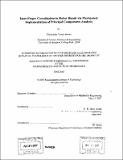| dc.contributor.advisor | H. Harry Asada. | en_US |
| dc.contributor.author | Brown, Christopher Yeates | en_US |
| dc.contributor.other | Massachusetts Institute of Technology. Dept. of Mechanical Engineering. | en_US |
| dc.date.accessioned | 2008-01-10T15:49:48Z | |
| dc.date.available | 2008-01-10T15:49:48Z | |
| dc.date.copyright | 2007 | en_US |
| dc.date.issued | 2007 | en_US |
| dc.identifier.uri | http://hdl.handle.net/1721.1/39873 | |
| dc.description | Thesis (S.M.)--Massachusetts Institute of Technology, Dept. of Mechanical Engineering, 2007. | en_US |
| dc.description | Includes bibliographical references. | en_US |
| dc.description.abstract | Postural synergies describe characteristic patterns of actuation in human hands arising from biomechanical constraints, physical tendon coupling, and neurological control schemes. Often, a small number of synergies contain much of the information required to describe an entire human hand posture, with 80% or more of the total information encoded in only two component values. Synergies have commonly been used to identify hand shapes with minimal processing power. However, they can also be used to recreate postures in robot hands, by allowing a mechanical implementation of inter-finger coordination. This can provide benefits of reduced cost, compact size, and decreased actuator count. In this paper, a novel mechanism is proposed to drive a dexterous, versatile, 17 degree-of-freedom robot hand using only two DC motors. Posture data was collected with a dataglove, and analyzed using principal components analysis to determine the postural synergies. The synergies are then mechanically hardwired into the driving mechanism, resulting in a concept dubbed eigenpostures. | en_US |
| dc.description.abstract | (cont.) Two eigenpostures effectively recreate the entire posture set. Several observations and suggestions are presented on tendon-drive robotic hand design in general, and also specifically targeted towards synergy- or eigenposture-based design. Avenues for further research into synergy mechanism design are proposed, including a powerful concept incorporating k-means clustering with principal components analysis to distinguish between high-precision and low-precision tasks, and greatly reduce overall error. | en_US |
| dc.description.statementofresponsibility | by Christopher Yeates Brown. | en_US |
| dc.format.extent | 89 p. | en_US |
| dc.language.iso | eng | en_US |
| dc.publisher | Massachusetts Institute of Technology | en_US |
| dc.rights | M.I.T. theses are protected by copyright. They may be viewed from this source for any purpose, but reproduction or distribution in any format is prohibited without written permission. See provided URL for inquiries about permission. | en_US |
| dc.rights.uri | http://dspace.mit.edu/handle/1721.1/7582 | |
| dc.subject | Mechanical Engineering. | en_US |
| dc.title | Inter-finger coordination in robot hands via mechanical implementation of principal components analysis | en_US |
| dc.type | Thesis | en_US |
| dc.description.degree | S.M. | en_US |
| dc.contributor.department | Massachusetts Institute of Technology. Department of Mechanical Engineering | |
| dc.identifier.oclc | 181643569 | en_US |
